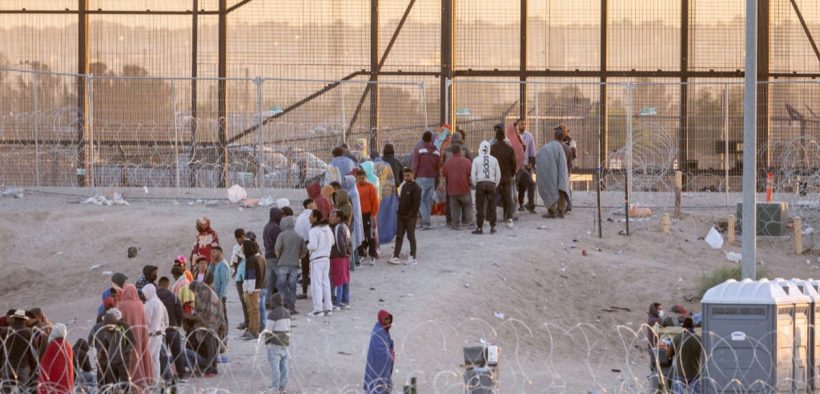Biden has another calamitous year at the southern border in 2023 as records shatter
Share

It was another turbulent year in 2023, marked by political dysfunction at home and two major world conflicts. ‘America’s Newsroom’ anchor Bill Hemmer looks back at the top headlines of the past 12 months.
After two years of chaos at the southern border, 2023 was seen as a year the migrant crisis could be brought under control.
But it was not to be, and the border enters 2024 in the grips of a record-setting surge.
The year started after December 2022 saw a record 252,000-plus encounters at the border with the Title 42 public health order, which allowed for the rapid expulsion of migrants at the border, still in place but facing a looming legal challenge before the Supreme Court.
In early January, the Biden administration announced a number of new measures to bring order to the border, while pushing Congress for more funding and immigration reform.
Biden visited the border and later announced a program for Cubans, Haitians, Nicaraguans and Venezuelans that would allow 30,000 to fly directly into the U.S. each month and be paroled into the country. It’s part of a strategy to expand “lawful pathways” for migrants so they don’t enter the U.S. illegally.
“The actions we’re announcing today will make things better but will not fix the border problem completely,” Biden said.
Separately, the administration expanded the use of the CBP One app, which had been primarily used for inspections at ports of entry, to allow migrants to make appointments to be exempted from the Title 42 order and released into the U.S.
Republicans blasted it as a “concierge” service for migrants.
Numbers dropped sharply over the coming months, down to 156,000 encounters in February, but a new challenge loomed as the Biden administration moved to end the COVID-19 national emergency. That meant Title 42, instituted in March 2020 due to the pandemic for rapid removals, was also ending. The halt to that policy was met with delight by activists and Democrats who said it was cruel and outdated.
The administration announced expulsions would end May 11 and drew up a broad strategy to deal with an expected surge that would follow. It included continued use of CBP, increased use of expedited removal, anti-smuggling actions and a rule to make migrants ineligible for asylum if they crossed illegally and failed to claim asylum at a country through which they have previously traveled.
Numbers surged in the weeks leading up to May 11, with over 10,000 encounters a day as migrants rushed to the border. Chaos was predicted once the order ended, and both Democrats and Republicans demanded the administration extend the order.
But the opposite happened. Numbers dropped, both through the end of May into June, when numbers hit a low of 144,000 encounters. While still high compared to pre-2021 numbers, the June numbers were the lowest since early 2021. Numbers went up in July, but only slightly. The administration hailed it as a sign its post-Title 42 strategy was working.
“Our approach to managing the borders securely and humanely even within our fundamentally broken immigration system is working,” DHS Secretary Alejandro Mayorkas said at a House hearing in July. “Unlawful entries between ports of entry along the southwest border have consistently decreased by more than half compared to the peak before the end of Title 42.”
But the celebrations were premature. Numbers shot up to 232,000 in August and 269,735 in September, a new monthly record. October’s 240,000 encounters were the highest on record for that month.
The political implications of the crisis increased, and budget discussions began to snarl as conservatives demanded sweeping changes, calling for asylum limits and restrictions on the administration’s use of parole and additional border security.
Meanwhile, Democratic mayors in cities like New York City and Chicago, where migrants had flocked in the tens of thousands, increased pressure on the administration to do more, in addition to the billions of funding the feds had already provided.
The administration granted temporary protected status (TPS) to hundreds of Venezuelans, allowing them to get work permits, but those mayors said it wasn’t enough, and they called for $5 billion in additional funding.
The White House called for an additional $14 billion in supplemental funding, including for increased removals, funding for communities and more processing and border agents. But Republicans have continued to press for asylum limits. House Republicans have called for their entire border package passed earlier this year to be included, while a Senate working group offered a slimmed-down package.
The White House has said it is open to “significant compromises” and has reportedly opened the door to a Title 42-style authority, greater detention and greater expedited removal. Liberal Democrats balked at that suggestion, some saying any policy changes must be accompanied by amnesty for illegal immigrants already in the U.S.
Lawmakers attempted to thrash out a deal before the Christmas break but have so far been unsuccessful.
Late 2023 saw yet another surge at the border, breaking multiple records. Sources told Fox that December was on track to break the record for monthly encounters, marking an unfortunate end to a tough year at the border for the administration.
Continue Reading at Fox News.













